by Briscoe White | Dec 1, 2011 | Flowers, Gardening, Growing, Herbs, Life on the Farm |
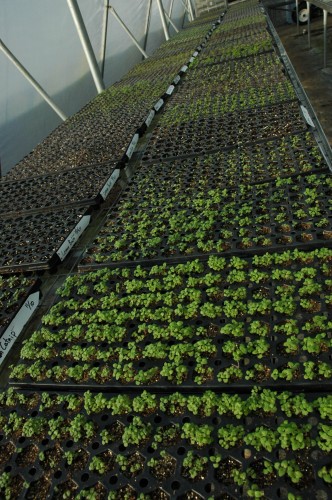
While everyone is running around finishing holiday shopping, we’re busier than Santa’s elves in our greenhouse. Introducing a few new techniques and tricks of the trade, we’ve been hard at work planting and preparing our herbs and flowers for their debut this spring. Hand-planted and all grown in our greenhouse, we get to know the different personalities of these plants like old friends. For instance,we know that though aromatic and beautiful, Lavender can be cranky about too much water. Or that Horehound, a medicinal herb and cousin to Mint, is easy going and grows quickly. Knowing our plants from the time they germinate allows us to have the best quality control over what we sell, and we have high standards for our plants because if we wouldn’t want it in our own garden, we won’t ship it. This is the benefit to a family-owned nursery versus a big box store or corporate grower. We care about the plants we grow. Like an anxious, proud papa, I eagerly check the germination chamber constantly each week to see if any “due dates” have arrived early.
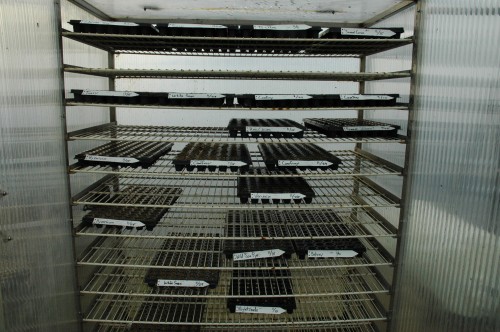
Looks like some of the first Betony seeds are beginning to sprout!
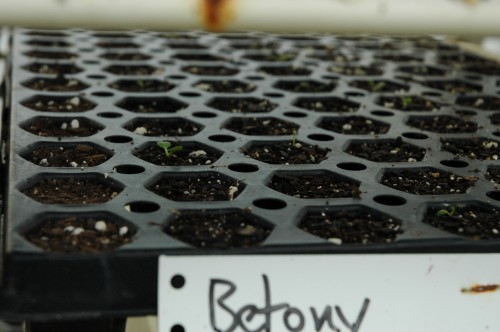
Stay posted for more pictures and news on how your favorite herbs and flowers are growing! You can actually watch the progress of your order, from their inception in our greenhouse, to their maturity in your garden. Order these babies now and reserve yours for spring shipping, because the early bird does get the worm!
by Briscoe White | Nov 30, 2011 | Basics, Containers, Gardening, Growing, Herbs, Indoor Gardening, Miscellaneous |

As the sun began setting here in Zone 7 yesterday, I looked at my watch and couldn’t believe that it was only four o’clock! While the darkness descended around our farm, I thought to myself how depressing the winter months can be for gardeners, especially if they don’t have any garden lights set up. A severe decrease in sunlight plus plummeting temperatures are a bit of a shock after such a long, warm summer. So, what is an avid gardener to do? Bring your herb garden indoors and make your own light! You could even decide to get some street lights (or as people in France would say “Lampadaire exterieur“) that can be placed in your garden so you can keep your herbs out there for just a little bit longer. Until the time comes when it really is that cold and dark that you have no choice to bring them inside.
An ideal indoor lighting setup for growing herbs throughout the winter would be to have a ton of south facing windows with lots of space to line your herbs along the window sills. It might be useful to consider smart home lighting to have better control over your home lighting in these darker periods of the year and works well with this situation. If this scenario isn’t a reality, you can also line your ceiling with fluorescent grow lights to accommodate your indoor oasis while sunlight is scarce. Something like these barn gooseneck lights are also useful, whether wall mounted or ceiling mounted. These provide enough light to grow herbs and are also convenient for home use. Though many herbs may go dormant, like Mints, as per their natural seasonal cycle, artificial lighting can extend their growing season and keep them useful. Most culinary herbs are well suited as indoor potted herbs, like Rosemary, Thyme, Chives, Winter Savory or Garden Sage, and tend to do well with supplemental light. Growing an indoor herb garden is a wonderful way to beat the winter doldrums and will provide you with fresh flavors until spring thaws the ground outside. Until the days grow longer, you can supplement your home’s natural lighting with fluorescent grow lights to keep your herbs growing strong all winter long.
Many herbs tend to get a big leggy under fluorescent lighting, so make sure to keep them pruned well for better growth. Growing herbs indoors can also affect the water levels your plants need, so also pay close attention to the amount of moisture your herbs require to keep them from drying out. The type of pot or container your herb is growing in can also affect the amount of moisture it retains. Terra Cotta pots work well, as most herbs do not need a lot of water and the porousness of the clay allows excess moisture to escape. Mature herbs should be placed a few feet away from the light source, while sprouts may need to stay within a few inches until they get established.
Florescents are more efficient than many other lighting options because they are much brighter and more narrow, and due to lack of surface space, they waste less. If you can afford the space for this endeavor, try lighting that falls between 4000 and 6000 Kelvin, a range that is warm enough to mimic the lighting environment of a greenhouse, without being too hot that it fries your herbs. Color temperature is measured in Kelvins, and is an important characteristic of visible light- especially when we’re talking plants. The lower degree of Kelvin or color temperature, the more warm the lighting feels, and the higher the Kelvin, the cooler the light feels. Think of the difference between cozy warm lighting in your home versus the harsh, cold lighting of your doctor’s office. By choosing fluorescence that falls between 4000 and 6000, you allow for a healthy spectrum of warmth and color for most culinary herbs. (Some of the more tropical or sun loving plants like Stevia or Ashwagandha may take a bulb with a fuller spectrum of light). Many herbs need at least fourteen hours of light a day to stay happy indoors, and getting a timer for your lighting may be a good idea to help with this, as well as prevent them from running too long and wasting energy.
For a better idea of how the Kelvin system works, see the chart from 3drender.com below :
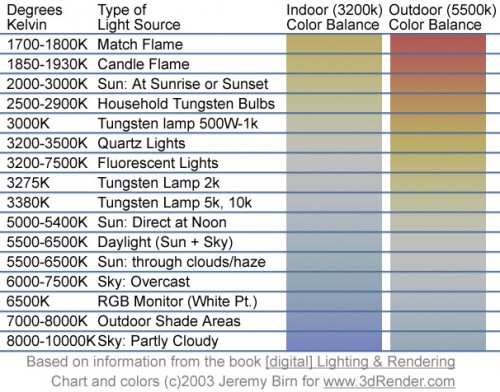
by Briscoe White | Nov 22, 2011 | Herbs, Life on the Farm |
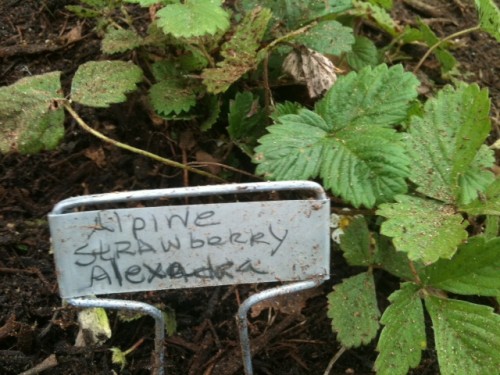
A great way to add personality to your garden (and help you recall what you planted!) is to label your plants with plant markers. Whether you prefer common names, Latin names, their uses (potpourris, teas, plants that attract specific butterflies, etc) or labeling by types of cuisine, plant markers are a terrific way to keep track of your plants and educate visitors who may stroll through your gardens.
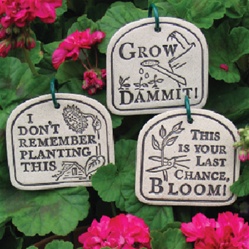
Try showing your humorous side with some of our Stone Plant Tags, and we promise you’ll get a good giggle each time you garden.
We’re finishing our test garden this week as we tidy up for Thanksgiving. After planting so many different types of herbs throughout our landscape, it can be enough to make your head spin! Labeling our herbs gives us a reminder of which varieties we have, making it much easier to run out and snip a few sprigs of Lavender for craft making or Lemon Thyme for our Thyme For Cupcakes recipe! For a great gift for the gardener in your life, try our stylish set of six Slate Garden Markers or our decorative Copper Hang Tags for a more rustic feel.
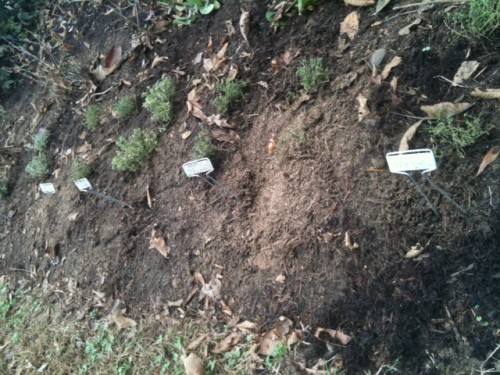
Stay tuned for more news from our test garden, as we showcase our favorite herb plants!
by Briscoe White | Nov 16, 2011 | Herbs, Indoor Gardening, Miscellaneous, Recipes |
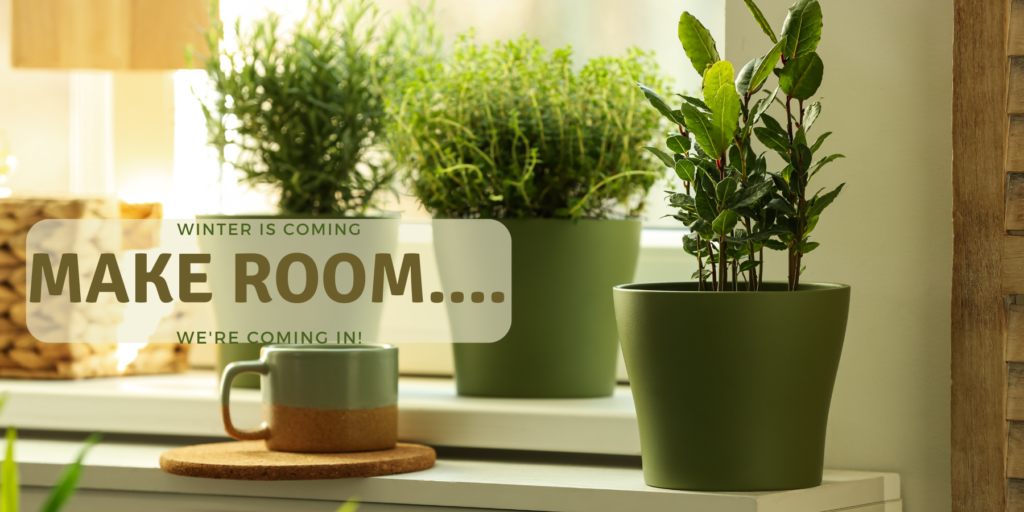
The time has finally come where the nights are getting crisper and the threat of frost is upon most of us in zone 7. While the fall foliage is beautiful, it marks the end of many outdoor gardening tasks until spring thaws the ground again. Before you begin to panic and go harvesting your herbs for drying and freezing, consider transplanting them for indoor use to enjoy fresh flavors all winter long. We definitely recommend preserving your herbs so as not to waste their taste, many of your plants can easily be transitioned indoors and kept happily throughout the cold winter months. Keeping your herbs indoors will ensure a wealth of fresh flavor and natural aroma for all of your hearty winter dishes, holiday meals and hot teas. Keeping your plants indoors will also promise to cheer you up through the winter doldrums and keep your home smelling green and clean without the toxic effects of synthetic air fresheners.
Choose Wisely
Plants like Rosemary, Bay, Lavender and Lemon Verbena will pot very easily and do well over the winter, as do most culinary herbs. For plants that go dormant during this time of year like Mints (they tend to get leggy), you may need to enhance the lighting in your home with grow lights to encourage the plants out of their natural cycle. Herbs need approximately 14 hours of light a day, and about 6-8 hours of direct sunlight to maintain healthy growth. As you’re considering which herbs to bring in, make sure you also consider proper indoor locations for your plants. Southern facing windows will get the most amount of light daily, and as the days grow shorter moving into winter, make sure to accommodate for the waning sunlight by rotating your plants and substituting with alternative light sources.
Transplanting
A few weeks before your area gets its first hard freeze of the year, it’s best to transplant your desired herbs into pots for the winter. Choose only the healthiest plants, leaving any wilted, broken or feeble plants for the compost pile. Dig your plants carefully, and try to extract the entire root system. Once your plants are removed from the ground, pot them into new containers with new potting soil to prevent spreading any disease. Make sure to pot them in deep pots and leave them outside for a few days to acclimate to their new environments before bringing them inside.
Find The Right Spot
Once your plants have recovered and have been moved inside, make sure to not only choose a sunny location, but also consider the temperature and humidity in the area they are placed. For example, you wouldn’t want to place your plants on the mantle of your fireplace that you enjoy using, as they will dry out quickly, just as you don’t want to place them near a drafty door as they may get too cold. Monitor their needs for a while to see if they need more or less water and pay attention to their color and growth. Typically herbs don’t need a lot of water, and you can maintain this by sticking your finger about a half inch into the soil to test for moisture. As long as the temperature in the room does not go below 50 degrees your plants should be warm enough to keep growing.
For more information and some tips on growing herbs indoors, see our article Growing Herbs Indoors.
by Briscoe White | Nov 7, 2011 | Miscellaneous |

When many people envision their garden, they feel the need to choose between fashion and function — Flowers or Herbs. Yet, little do they know, that the two can be combined to enjoy the best of both worlds. We tend to forget to appreciate herbs in our garden, focusing mainly on the end product- their flavor. So what does an herb offer for your landscape?
Contrast
Herbs add depth and contrast to your existing flower gardens, by offering a myriad of verdant colors that enhance the color of your buds and blooms. By filling space around, between, and under your existing flowers, herbs allow the blooming colors to seem more vibrant. Essentially, they frame your flowers without detracting from their beauty. The many textures of their varying foliage also make your garden more interesting, and you can alternate from glossy, dark green Basils such as the Italian Large Leaf Basil, to the variegated leaves of the low-growing, Pineapple Mint. Wonderful Golden Variegated and Silver Edged Thymes, Tricolored Sage and Amethyst Basil are just a few of the naturally stunning plants that add can compliment your flower garden, with little effort to maintain.
Color
Many herbs themselves have beautiful blooms that often go overlooked or undesired if grown solely for their culinary benefits. Once an herb beings to bloom and goes to bolt, the flavor profile may change, so culinary herb gardeners tend to prune the flowering tops of these plants to preserve the herb’s flavor intensity. If left to flower, most herbs display beautiful spires, clusters and sprigs of color that will continue all summer long. Pineapple Sage, Rosemary, Basils and Fennel are just a handful of culinary herbs that may be best left un-snipped to allow their blooms to attract wildlife and lend beauty to your landscape. Other herbs not traditionally used to cook with that provide an array of color are Clary Sage, Joe Pye Weed, Sweet Woodruff and Rue.
Naturally Beneficial
Many herbs have natural insect and pest repelling properties that will actually help protect your neighboring flowers from outside attacks from unwanted visitors. Incorporating your landscape with these non toxic defenders will ensure a healthier garden and less stress for you, too. Herbs like Bergamot and Chives which will deter deer and Tansy which repels Japanese Beetles, have wonderful blooms that will look great while safeguarding your other plants. Not only will these flowering herbs keep pests out, but their sweet scents will help entice valuable pollinators like hummingbirds, bees and butterflies to encourage the pollination and growth of your garden. Many herbs are havens for very specific types of butterflies, such as the Monarch Butterfly, which tends to favor Fennel flowers.
Planning Is Key
Gardening with herbs does not have to be complicated; with a bit of planning and a little imagination, you can either use herbs to transform an existing bed or start completely from scratch. In either case, it is important for you to do some preliminary groundwork. Determining the purpose for your garden is one of the first steps to enjoying it. Having an end use in mind will help dictate what and how you plant. For example, a kitchen garden might be best planted close to your back door for easy access to fresh herbs while you cook. You want those fresh flavors close at hand when you need a sprig of Tarragon and don’t want to trek across your yard.
What space do you have to work with? Remember that your plants will mature quickly and flush out beautifully, so space needs to be a consideration when planning. It wouldn’t hurt to consult with a california lawn care specialist to get a different perspective on how you might tackle the job. I’ve made the mistake of planting starter plants too closely and they end up choking each other out. Save yourself the future headache and allow at least three to eight feet for a perennial herb and about one to three feet for an annual. This will ensure that your plants have plenty of space to stretch out and grow. The height and spread of each plant, are also important in terms of light. Make sure to plant your more dramatic, upright herbs closer to the back, leaving ample space for low lying, creeping herbs like Thyme closer to the front where they may still get plenty of light. Your herbs will need at least six hours of direct light a day, and if you invest in perennial plants, you’ll have to plan for shifting sunlight as the days get shorter, moving into the Fall season.
The soil that you start your garden in, is just as important as the amount of light the area gets. Herbs need well draining soil, and some, like Lavenders are particularly fussy about “wet feet”. Test your soil and plant accordingly. You may even want to add sand or organic compost to different parts of your garden, to cater to the specific needs of certain plants. That being said, study up on each plant. Even the “usual suspects”. Knowing each plant’s specific needs will allow you to provide for them and diagnose any unforeseen issues that may arise. (It’s also a good way to make sure you’re not planting unwanted plants like invasive species.)
It helps to plot out your garden on paper first, before you break ground. This is a wonderful way to spend your cold winter nights. Just curl up with some graphing paper and a pencil, with a cup of hot chocolate begin to dream and scheme about the spring. Thinking ahead will keep you company through the cold and you’ll be ready to get started as soon as the ground thaws.This will save you a lot of trouble and it will ensure that each plant gets the proper attention and resources that it needs.
It’s time to reinvent the way we look at growing herbs and remember to choose them for their colors, textures and blooms. Many herbs are perennial and will remain long after your flowers fade. Most need little water and don’t prefer to be fertilized, making them very simple ways to round out your landscape for a more interesting look. So this spring, as you’re buying plants and making plans for your yard, consider adding herbs not just for their flavor, but for the beauty the can bring to your favorite spaces.









